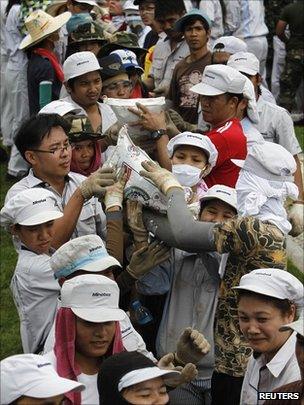Thai flooding: Key business park Navanakorn evacuated
- Published
People are helping to shore up flood defences on the outskirts of Bangkok
One of Thailand's oldest and largest industrial estates has been evacuated after flood waters breached its recently-fortified defences.
It comes as officials say most of Bangkok appears to have escaped the flooding, although some parts of the capital are still under threat.
Water began seeping into Navanakorn industrial estate in Pathum Thani, 45km (30 miles) from Bangkok, on Monday.
Navanakorn houses some 250 factories, employing up to 200,000 people.
As many as 1,000 soldiers and factory workers worked over the weekend, filling sandbags, reinforcing dykes and repairing holes.
Prime Minister Yingluck Shinawatra on Sunday had expressed optimism that Navanakorn would be spared, but admitted on Monday their efforts had failed.
"I feel so sorry that water has entered because we've been trying to prevent the industrial estate from flooding for quite a while," she was quoted by the Bangkok Post, external as saying.
She said the barriers had been breached by a combination of heavy rain over the weekend, high tide levels as well as large amounts of water running-off from the flood-hit north of the country.
Navanakorn is not the only industrial estate to have been affected. Five industrial estates in the badly-flooded province of Ayutthaya have been damaged, including Factory Land, which is reported to be under 1.5m (5ft) of floodwater.
Many of these industrial estates house both local and international factories and businesses - a large number of which make electronic components and car parts.

Workers at the Navanakorn industrial park have been helping to reinforce flood barriers
A number of firms - including Japanese carmakers Toyota and Honda - have been forced to suspend production because of damage to facilities or disruption to local supply chains.
The government predicts costs to the economy could total more than $3bn (£1.8bn).
Ms Yingluck is to meet with industry representatives to discuss how best to help flood-hit companies, the Bangkok Post reports.
Danger not over
Bangkok itself was breathing a bit easier on Monday, having been on a state of alert over the last few days amid fears it would be hit by the combination of run-off waters, high tides and heavy rain.
Agriculture Minister Theera Wongsamut said on Sunday there were "good signs" that water levels on the city's key Chao Phraya river would rise no higher.
"A large amount of water from the north flowed past Bangkok to the Gulf of Thailand yesterday," Mr Theera said.
However, Bangkok Governor Sukhumbhand Paribatra warned on Monday that the danger was not over, particularly for the Sai Mai district. He said there were reports that flood defences in many areas had been breached, and Khlong Sam Wa district might be affected, the Bangkok Post reports.
And the story is much worse for areas north of Bangkok, which have borne much of the brunt of the flooding.
The BBC's Rachel Harvey has flown over the affected region and says that, for as far as the eye can see, the area is waterlogged. Only the tops of trees and the roofs of factories and houses can be seen above the water.
The area is going to be under water for many weeks and those who have lost their homes and livelihoods will need help for a long time to come, she says.
More than 300 people have now lost their lives since the floods which began in late July, due to heavy monsoon rains.
Neighbouring Cambodia has also been hit hard, with the loss of almost 250 people and 17 out of 23 provinces affected.

- Published15 October 2011
- Published13 October 2011
- Published11 October 2011
- Published11 October 2011